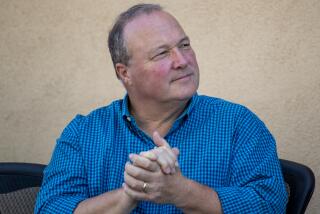Left, Right--the Cameos Come From All Sides in âTrafficâ
How strange is it to find one of Washingtonâs most outspoken critics of movie violence appearing in a new, violence- and cocaine-laced film about the drug war? Not only does Sen. Orrin Hatch (R-Utah) have a cameo role in the new Steven Soderbergh film âTraffic,â but a host of other senators and anti-drug government officials play themselves as well. The minor roles suited everyoneâs purposes: Hatch and other senators took a stand against drugs, and the film gained a heavy dose of realism.
âTraffic,â which opened Friday, stars Michael Douglas as a newly appointed âdrug czarâ who takes on two Mexican cartels while, unbeknownst to him, his daughter battles drug addiction. When Douglasâ character arrives in Washington, he is approached at a cocktail party by a bevy of politicians pushing their agendas and offering advice. (The film has already garnered a number of awards from critics.)
âWe invited a bunch of senators to participate,â said producer Laura Bickford. âBeing liberal Hollywood types, the ones we called first were the Barbara Boxers and the obvious ones, like Ted Kennedy. Then we thought, âWell, we want some Republican senators too,â and the crew got into it. People began calling their own senators. . . . We called Sen. Hatch because heâs so well known, and we wanted the most identifiable face in that scene.â
The politicians, including Sens. Boxer (D-Calif.), Charles Grassley (D-Iowa), Harry Reid (D-Nev.), Don Nickles (R-Okla.) and former Massachusetts Gov. William Weld, all played themselves. âTheyâre all quite good speakers, and itâs not like theyâve never stood in front of a camera before,â said Bickford, âso it worked out really well.â
That Hatch, a vocal critic of what he deems excessive violence in movies, has a cameo role in a movie with graphic depictions of drug use, sex and violence has not escaped notice. He agreed to appear in âTraffic,â however, after being assured that the movie would neither glorify drug use nor contain what he considers gratuitous violence. âThe first question we had is âWhat is the movie rated?â â said Hatch spokesman Christopher Roche. âWe said, âWe really have to know: Is there anything thatâs going to make it embarrassing for a U.S. senator, particularly a Mormon U.S. senator, to participate in this movie?â â
Hatch, who has seen the movie, might tone down some of its violence, Roche said, but generally approves of its depiction of drug use as spiritually and physically devastating. âHe would say that in the past, some movies and television shows have glorified the drug problem,â said Roche. âHe welcomes any kind of movie that shows its ugly side; too many kids think drugs are fun, and heâd like to see that fallacy shattered.â
The cocktail party scene was shot last summer at the home of C. Boyden Gray, former White House counsel to President George Bush. The senators and Weld met Douglas and Soderbergh just before the cameras rolled. They were not given lines; instead, they were instructed to tell Douglas exactly what they might tell a new âdrug czar.â Hatch told him to be his own man.
Nickles agreed to the cameo to raise questions about the cost of the war on drugs. âWhat is victory?â he asks on camera.
Throughout the movieâs development, from writing to filming, Hollywood and government meshed in surreal ways. For example, the movie employed about 30 actual customs officials, who auditioned for parts, formally sought permission for outside employment as actors, then portrayed themselves at work. Also, after customs spokesman Dennis Murphy complained about aspects of the script, he found himself rewriting parts of a scene at Soderberghâs request. âHe astounded me by saying, âWhy donât you take a shot at rewriting the sections of the script you have a problem with?â We kind of all chuckled, but I did it,â Murphy said.
The working relationship was so good that when it came time for the Douglas character to witness how drugs are intercepted at the border, customs allowed the filmmakers to use a car that had been impounded that morning, with its cargo of cocaine still inside.
The Drug Enforcement Administration became so comfortable with Soderbergh that, for the first time, it allowed a film crew inside its operation at the El Paso Intelligence Center. âWe shot on a Saturday, and some of the people who normally work at their desk during the week were hired to do the same thing that weekend,â said Craig Chretien, former director of intelligence for the DEA.
Chretien started as a consultant on âTraffic,â reviewing the script for realism, but then agreed to play a small part. So real did his conversation with Douglas become that, at one point, Soderbergh had to stop shooting. âI didnât realize it, but I was talking about people in the cartels in Mexico and using their real names,â Chretien said. âDouglas grasped a lot of complicated material quickly. He asked better questions than some senior officials Iâd briefed over the years.â
Nonetheless, once in front of the camera was enough. âI have a lot of respect for the movie industry,â said Chretien, âbut I think Iâll keep my day job.â
*
In Sunday Calendar
* How âTrafficâ director Steven Soderbergh got his film made.
More to Read
Only good movies
Get the Indie Focus newsletter, Mark Olsen's weekly guide to the world of cinema.
You may occasionally receive promotional content from the Los Angeles Times.










